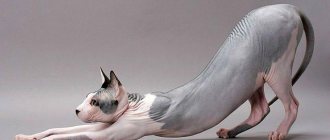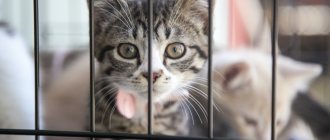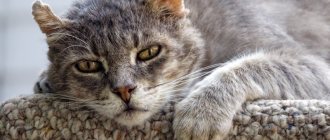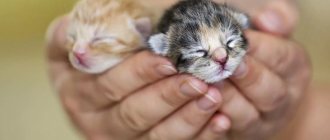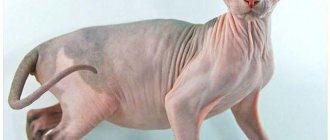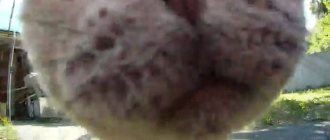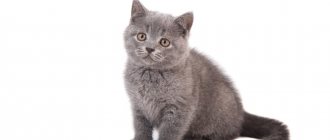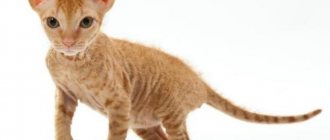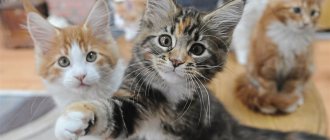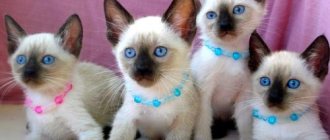Sphynxes are unusual cats that resemble aliens from another planet. Due to a genetic mutation and careful selection work, their body is completely or partially hairless. Because of this, representatives of the breed have a higher body temperature and require special conditions of detention.
Let's figure out how to care for the Sphynx in order to provide it with a comfortable and fulfilling life.
Preparing for the arrival of a kitten
In order for the process of weaning from its mother to take place without damage to the physical and psychological health of the little sphinx, it is taken to a new home no earlier than three months of age.
Representatives of this breed are usually reserved long before they are 12 weeks old. Therefore, happy owners have enough time to learn more about the features of caring for a kitten and prepare for its arrival.
To create decent living conditions for a hairless baby, they buy a “dowry” in advance:
- bowls for water, dry and wet food;
- carrying bag;
- tray with filler;
- scratching post;
- toys;
- grooming tools (nail clipper, toothbrush, etc.);
- hygiene products (ear cleaning lotion, toothpaste, etc.);
- bed or house.
In order to provide the little sphinx with not only proper care, but also safe living conditions, the apartment is also prepared for his arrival. Wires, indoor plants, household chemicals, fragile and small objects are hidden in advance from a curious and playful kitten.
On a note. When kept at home, inquisitive sphinxes try to explore every corner of their new property and often get into the most unexpected places like the oven or washing machine. To avoid tragedies, it is better to keep the doors of these devices closed, and before using the equipment, it is better to look inside once again to make sure that there is no little prankster in there.
Origin story
The history of this breed began in 1966 in Canada. This year, a kitten named Prun appeared in the litter of the most ordinary cat in the yard. He was completely bald. To retain this feature, he was crossed with his own mother. The resulting offspring were normal and hairless kittens. Similar matings were carried out several times, each time obtaining the same result. In the 70s, individuals were obtained that were devoid of hair, practically no different from modern representatives of sphinxes.
Since the breeding was carried out by non-professional breeders, but only by amateurs who had a limited genetic fund, the breeding of this breed was extremely slow, and most of the kittens did not survive or were born dead and non-viable. In 1975, another hairless kitten was born in the American state of Minnesota. His name was Epidermis. A year later, his mother brought another such baby. Both were placed in a kennel.
After some time, several more kittens were born in Canada. The Canadian Sphynx acquired its final appearance in Holland, where professional breeders began breeding this breed. The first kittens were brought to our country from the USA in the early 80s.
Features of caring for the Sphinx
The exotic exterior cannot but affect the needs of the cat’s body. Therefore, it is better for potential owners to study in advance the features of care and maintenance of sphinxes.
Hairless cats have nuances with thermoregulation. Sphinxes do not tolerate dampness and drafts well. To protect representatives of the breed from hypothermia and colds, the room is maintained at a constant temperature within 20-25 °C. If this is not possible, the hairless cat is dressed up in a warm vest or blanket.
Sphynxes love warmth and love to bask in the sun. To prevent burns from leaving on the delicate skin, cats of this breed should not be exposed to ultraviolet rays for a long time.
Breeding
Now Canadian Sphynxes are gaining popularity, more and more nurseries and breeders are appearing. Finding a partner for mating is not difficult, especially in large cities. In almost all millionaire cities there are places where you can buy a purebred specimen. There are especially many of them in Moscow and the region.
Mating
This is a complex process that must be organized at the proper level. It is important to create the right conditions for this to happen correctly. Puberty in Canadian Sphynx cats begins at one year of age, and the first estrus begins at 6 months. Cats begin to mark at about one year of age.
Pregnancy
The female's pregnancy lasts 62-68 days, 65 days on average. In some individuals it can last 58-70 days. During this period, the cat should have increased nutrition and increased feeding frequency. The cat should receive a portion of food 20-30% larger than usual, and the frequency, instead of two, should be increased to 4-5 times a day.
Nursing Sphynx cat with kittens.
Castration and sterilization
The operation is performed on males and females and lasts from an hour to three. The operation is performed under general anesthesia. If the owner does not plan to breed the breed, it is recommended to carry out this procedure in order to save the animal from physiological and psychological torment.
The right diet
In order for the Sphynx to develop well and remain healthy longer, it is provided not only with proper maintenance and care, but also with balanced feeding. To remain active and maintain body temperature, hairless cats require more high-calorie food than representatives of shaggy breeds.
On a note. If the Sphynx's diet is low in fat, the animal will become cold and begin to overeat to make up for the lack of energy. And this is fraught with digestive problems.
With the industrial type of feeding, high-calorie products of premium or super-premium class are purchased for sphinxes. Before making a choice, you need to carefully study the description of the composition and make sure that it has sufficient fat content and there are no questionable components.
The following criteria are met:
- Royal Canin;
- Acana;
- Grandorf.
With a natural diet, the Sphinx's menu is designed so that it contains at least 70% meat. Also included in the diet of cats of hairless breeds is:
- boiled offal;
- porridge with water;
- vegetables;
- eggs;
- dairy products;
- lean sea fish.
It is important to ensure that cats of this breed never eat bones, baked goods, sweets, smoked meats, pickles and sausages. Also, sphinxes should not be given mushrooms, onions, river fish, fresh milk and any leftovers from the master's table.
Keep your distance
If the cat cannot be weaned from bad manners by loudly shouting “no!”, sometimes it is allowed to use the method of intimidation. This means that at the moment the “crime” is committed, the animal must experience a feeling of fear, for example, hearing a sharp bang or a piercing whistle. But under no circumstances should she be allowed to consider her owner a source of fear. If you want to discourage your cat from bad manners by using deterrence, hide before you make any noise that will scare him!
Training and education
The affectionate and sociable nature of Sphynx cats, combined with high intelligence and good memory, make them ideal pets suitable for home keeping. A well-mannered cat will not damage furniture, ride on curtains or do other dirty tricks. Therefore, it is extremely important to have time to form the correct model of behavior in the kitten in the house.
On a note. You need to raise a Sphinx without using physical force. To stop unwanted actions or calm down an overly naughty kitten, you can lightly shout at it, splash water, or hiss threateningly.
Raising a Sphinx includes training in hygiene procedures. The kitten is taught to be calm about bathing, trimming nails, rubbing eyes, cleaning ears and teeth.
Toilet training
Even if the breeder’s kitten regularly went to the litter box, this does not mean that in the new home he will not recover anywhere. Therefore, to prevent the apartment from turning into a latrine for a cat, from the first moment the pet appears, you need to pay attention to its toilet training.
Typically, kittens defecate after sleeping or eating. Noticing that the baby is about to go to the toilet, he is carefully picked up under the stomach and taken to the tray. As soon as he does his job, he will definitely be praised.
On a note. If the kitten went to the toilet in the wrong place, the puddle is blotted with a napkin, which is then placed in the tray. And the “crime scene” itself is wiped with water flavored with a small amount of citrus juice.
Description of the breed
All Sphynx cats have developed muscles and delicate skin. The head has large ears that resemble locators, and the eyes have a slight slant. All sphinxes have a high body temperature, this is a feature of the animal’s heat exchange; in this case, it is not necessary to contact a veterinarian. The average height of a cat is 30-40 cm at the withers, and its weight is about 5 kg. There are general standards that the entire Sphynx breed has. They also apply to all representatives of hairless cats.
You can read about the Burmese cat breed and its colors here.
Appearance and standards
There are basic features of the Sphynx breed, approved by international organizations, which breeders and nurseries involved in breeding these cat breeds must adhere to. The characteristic features of the sphinxes are:
- The head is of medium size, in the shape of a rounded wedge, the length should be greater than the width. The forehead should be flat, with a smooth transition between the bridge of the nose and the forehead. The muzzle itself is short with high cheekbones and clearly defined boundaries. The chin should be strong, creating a perpendicular line with the upper lip. The whisker pads are well defined, but the whiskers themselves (vibris) may be completely absent.
- Ears. They are the main objects of attention. They are large in size compared to the head. They are erect and open, with a wide base. The inside should have no fur at all.
- Eyes. Large, almond or lemon shaped. They have a narrowing on both sides, planted far apart. The color of the iris can be any, but must be in harmony with the overall color.
- The animal's neck is of medium length and has the shape of an arc with developed muscles.
- Body. It is of medium length with a developed wide chest, round in shape. The belly is also rounded. The back of the animal is rounded.
- The legs are of medium length and should be in proportion to the rest of the body. In this case, the hind legs are slightly longer than the front ones. The paws are oval in shape and have long toes on all limbs.
- The length of the tail corresponds to the general proportions of the body, with characteristic flexibility and grace, gradually tapering towards the end.
It is by these criteria that one can determine the purebredness of the breed, as well as determine the quality of the pedigree.
Canadian Sphynxes.
Coat and colors
The Sphynx's skin is thicker than that of other cats and has numerous folds. There are especially many of them on the face and paws. Outwardly, the animal looks completely bald, but in fact there is a small fluff on the skin, several millimeters long. The fur may be on the outside of the ears, between the toes, and on the scrotum. There is a classification of Sphynx fur, dividing it into different types:
Naked. Such animals are already born naked and are considered the most expensive and rare; they are highly valued by breeders. There is homozygous and undressed. The latter have an inconspicuous fluff that quickly disappears.- Flock. This coat is soft to the touch, very short and almost invisible. Sometimes it can disappear completely.
- Velours. This type of cover can be felt when you touch it, but the cat appears naked. To understand that a cat has a covering, you need to stroke it. Once a year the animal sheds. There are three types of velor - light, velor-point, down.
- Brush. The animal is born with dense, curly hair, the whiskers are curled. There are three types of brushes - brush velor, point, dense.
- Straight-haired. Such an animal has the fur of an ordinary cat, but the physique and character of a sphinx.
The Sphynx can be any color. These are all types of colors that are found in all cat breeds - solid, tortoiseshell, tabby and others.
What types of sphinxes are there?
Sphynxes can be very different; there are varieties of Sphynx breeds (Canadian, Don, Peterbald and others), according to the cover and structure of the coat (nude, flock, velor, brush, straight-haired).
Table of the main differences between the varieties of the Sphynx breed.
Based on this classification developed by felinologists, it becomes clear about the condition of the animal’s fur. Hairless animals are considered the most valuable individuals among breeders and breed lovers. The cost of such kittens is higher than that of others.
Naked Sphinx.
Flock.
Velours.
Brush.
Straight-haired Sphynx.
Is it true that there are no allergies to hairless cats?
This is one of the most common misconceptions associated with these animals. Many are sure that Sphynx cats do not cause allergies. In fact, allergies to Sphynx dogs exist. Firstly, Sphynx cats have fur that also sheds, causing problems for allergy sufferers. Secondly, this reaction is caused by the skin secretion that these animals secrete. This breed has an increased ability to do this.
Hygiene
To ensure that the Sphynx always has a neat and aesthetic appearance, he is provided with regular care, which includes a whole range of hygiene procedures.
Bathing kittens and adult cats
Despite the lack of hair, Sphynx cats need regular washing. Therefore, bathing procedures should become an integral part of caring for these animals.
Sphynxes are bathed once a month using baby gels or special shampoos for hairless breeds.
Important! Sphynx cats should not be dried with a hairdryer so that the hot air does not burn the skin. Therefore, after bathing, cats of this breed are dried with a towel and lubricated with baby cream.
Skin care
Sphynx cats have no hair, and their sebaceous glands produce a lot of secretion, which accumulates and turns into a brown crust. It not only makes cats look unsightly, but also causes discomfort. If left untreated, over time, the skin underneath begins to itch and emit an unpleasant odor. As a result, a cat of this breed develops inflammation and dermatitis.
Therefore, an important aspect of Sphynx care is regular cleansing of the skin. The body of a hairless cat is systematically wiped with special wipes or a moistened cloth, paying special attention to the folds.
Important! Improper or irregular care of the Sphynx leads to the formation of black spots on the cat's skin. The comedones are carefully squeezed out, and the affected area is treated with an antiseptic.
Eyes
Since Sphynx cats do not have eyelashes, they are prone to eye diseases. Grooming for the breed should include regular eye examinations.
In healthy cats, clear or brown discharge accumulates in the corners. Therefore, the eyes of the sphinx should be wiped daily with a cotton swab dipped in boiled water or chamomile decoction.
Important! If yellow or green discharge appears in the eyes, it is advisable to show the cat to a veterinarian.
Teeth
Caring for a Sphynx cat includes cleaning its fangs and incisors. This procedure is carried out at least 2-3 times a month using a non-foaming paste applied to a silicone brush or a special attachment.
Systematic care of your cat's teeth will help get rid of plaque, help strengthen the gums and serve as a preventive measure against the formation of stones.
Ears
Hair cats grow in their ears, which prevents the penetration of dust and dirt. Hairless Sphynxes have unprotected ears. Therefore, even with strictly residential care, caring for cats of this breed involves mandatory cleaning of the ear canal.
The ears of sphinxes are regularly wiped with a clean cloth soaked in a special lotion or Vaseline oil.
Claws
To ensure that a cat living at home does not damage furniture and walls, caring for it should include regular trimming of its claws. The procedure is carried out using a nail clipper very carefully so as not to injure living tissues or cause pain to the cat. If representatives of the breed do not have their claws shortened, then a considerable amount of money for repairs and renovation of furniture can be added to the cost of keeping the cat.
How to properly wash an animal?
Animals accustomed from childhood are very fond of water procedures.
In terms of water procedures, there are often no problems with cats. If you accustom your pet to water from childhood, he will willingly bathe, swim and frolic. At the same time, you can bathe your cat 1-3 times a week, depending on the degree of contamination of the skin. For washing, it is better to use a special shampoo, but regular baby shampoo will do. After washing, the animal should be wrapped in a terry towel and within a couple of minutes the cat will be completely dry.
If after bathing your animal's skin begins to peel, it is necessary to solve this problem as soon as possible. Baby cream, which is gently rubbed in a small amount into problem areas every time after hygiene procedures, will help to avoid overdrying. If the peeling still does not go away, it is better to take your Sphynx to the veterinarian. Perhaps the cat has an allergy, which is important to deal with correctly.
Vaccination
Sphynxes kept at home run the risk of becoming victims of viral and infectious diseases no less than their street counterparts. To protect cats of this breed from dangerous diseases, their care should include routine vaccination.
They are regularly vaccinated with a complex drug that stimulates the development of immunity to panleukopenia, calcivirosis and rhinotracheitis.
This is done for the first time when the kitten is 7-8 weeks old. After 4 weeks, the sphinx is revaccinated against the same diseases and against rabies. In the future, the cat is vaccinated annually, regardless of whether it is exclusively kept in an apartment or is on the street.
Important! Before vaccination, the animal must be subjected to antiparasitic treatment. Anthelmintic drugs are given to the cat 2 times with an interval of 10-14 days. The dose is calculated based on the pet's weight.
If you need to re-educate
It is more difficult to re-educate an animal with an already formed character, but it is also quite possible. First of all, you need to understand why exactly the cat is behaving badly.
A pet may act out because at one time he was indulged too much or was not given attention. In this case, use the same strategy as in raising a kitten: reward correct behavior and scold for unacceptable behavior. Sprays containing unpleasant odors for cats, such as citrus fruits, will help scare your pet away from places where they are not allowed.
An animal may be intimidated or aggressive if it has been abused by previous owners. In this case, you need to behave towards the pet as gently as possible and reduce punishment to a minimum. As with a kitten, avoid stress such as noisy guests or loud music. In difficult cases, it makes sense to contact a zoopsychologist.
Sometimes an animal can behave correctly in the presence of its owners, but spoil things when alone. This may be a consequence of ordinary boredom or protest if the animal does not have enough attention. In this case, it is worth purchasing more toys for your pet. If necessary, the cat can be locked in one of the rooms (you need to put a tray and water there). Sometimes the solution may be to purchase a second kitten.
Please note that a sudden change in behavior may indicate an illness in the animal. When raising a kitten, combine persistence and affection. Remember, your goal is to achieve mutual understanding with your pet, not to force him to obey.
Our readers' pets
Become authors, share photos of your pets Send a photo
Is it possible to train a cat
Mustachioed sneaks with a cunning look and hunting habits are not dogs devoted to their master and ready to obey. No offense will be said to the barking brothers. The small predator has a natural desire to dominate. A representative of the cat tribe cannot be forced, but she can be persuaded. Then she will fulfill the person’s request. Attachment to the owner is a vulnerable character trait of a proud animal, which allows him to instill unusual skills.
Video: pet turns off the light
The debate about whether cats can be trained has been going on for a long time. There is no consensus on this matter among owners, breeders and felinologists. It cannot be any other way: everyone makes their own arguments based on personal experience. For example, one argues that animals are not teachable. And he motivates with the story that he was unable to develop a conditioned reflex in his pet to the “Voice” command. The owner said this word for half an hour, showing the tasty “prize” to the adult Briton, and he looked at the man’s efforts with bewilderment. Even repeating the order along with “meow” turned out to be useless. Defenders of cat abilities say: pets feel a person so much that they guess the command even before it sounds. They are just pretending, playing at submission. Or they try to please in the hope of getting something tasty. And the owner is happy that the necessary action has been completed, and considers himself a tamer. The third judgment is also based on the example of the behavior of an already trained cat. Knowing exactly the meaning of the order, she refuses to carry it out. Not out of forgetfulness, but on purpose. We have to conclude that standard training with unquestioning execution of a person’s command is impossible. When the opportunity arises, your pet will always show a headstrong character.
